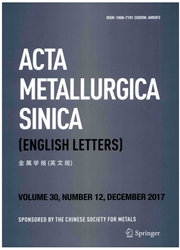

 中文摘要:
中文摘要:
电气化学的阻抗光谱学(EIS ) 和电影厚度测量被采用了学习在模仿的 coastalindustrial 气氛被薄电解质层盖住的捱过的钢的大气的腐蚀。结果显示腐蚀率是盖住的电解质厚度和湿 / 干燥的周期的功能。在每个湿/干燥的周期以内,增加的腐蚀率与增加的 Cl 有关<啜class=“ a-plus-plus ”>并且那么<潜水艇class=“ a-plus-plus ”> 4 <啜class=“ a-plus-plus ”> 2 集中和氧散开的改进与电解质的蒸发评价。另外,当湿 / 干燥的周期继续,腐蚀率在起始的腐蚀阶段然后减少期间增加。而且,一条数学途径基于数字集成,从 EIS 的大小获得钢的腐蚀团损失的方法被开发了,并且这将为室内的模仿的大气的腐蚀测试的发展是有用的。
 英文摘要:
英文摘要:
Electrochemical impedance spectroscopy (EIS) and film thickness measurement have been employed to study the atmospheric corrosion of a weathering steel covered with a thin electrolyte layer in a simulated coastal-industrial atmosphere. The results indicate that the corrosion rate is a function of the covered electrolyte thickness and the wet/dry cycle. Within each wet/dry cycle, the increased corrosion rate is related to the increased Cl^- and SO4^2- concentration and an enhancement of oxygen diffusion rate with the evaporation of the electrolyte. In addition, the corrosion rate increases during the initial corrosion stage and then decreases as the wet/dry cycle proceeds. Moreover, one mathematical approach based on the numerical integration method to obtain corrosion mass loss of steel from the measurements of EIS has been developed, and this would be useful for the development of indoor simulated atmospheric corrosion tests.
 同期刊论文项目
同期刊论文项目
 同项目期刊论文
同项目期刊论文
 Evolution of atmospheric corrosion of MnCuP weathering steel in a simulated coastal-industrial atmos
Evolution of atmospheric corrosion of MnCuP weathering steel in a simulated coastal-industrial atmos Evolution of corrosion of MnCuP weathering steel submitted to wet/dry cyclic tests in a simulated co
Evolution of corrosion of MnCuP weathering steel submitted to wet/dry cyclic tests in a simulated co A study of the evolution of rust on Mo-Cu-bearing fire-resistant steel submitted to simulated atmosp
A study of the evolution of rust on Mo-Cu-bearing fire-resistant steel submitted to simulated atmosp Atmospheric corrosion monitoring of a weathering steel under an electrolyte film in cyclic wet–dry c
Atmospheric corrosion monitoring of a weathering steel under an electrolyte film in cyclic wet–dry c 期刊信息
期刊信息
